
As a know how entrepreneur you have your own “killer app” – an asset either already revealed or writhing with potential – you have teaching content.
You have know how, and that can be leveraged to transform the lives of others for the better.
What do people buy? They buy a promised state change (and hopefully a real state change).
They want to go from X to Y, where X is the undesirable state and Y is the desirable state.
Good marketing and copy writing simply articulates the move from the before state to the after state.
Clarity 3 is all about movement.
The transformation is the bridge you create between the states ….. I call it transformational content, but you could substitute system, software, formula or product for “content” if you have a different business model.
Often called your signature system, this is your highest value know how. It is extracted from inside your head and heart or life’s work or experience. It is generally your most profound offer. It won’t emerge perfectly formed (it will definitely be messy at times) but defining it will be some of the best work you’ll ever do.
Why Define Your Transformational Content
Having a “signature system” in your back pocket gives you an ease and confidence that you can deliver the results your ideal clients want.
Any requirement for hard sell is lifted. Your offer is based on insight. Your Marketing will be empathetic and educational and your selling will be simple conversations.
Where is transformational content used in your business?
This is your foundation work, your deepest work, the repository of the your most valuable know how. This intellectual property becomes the foundation of your product set.
If I could distill one lesson from building a successful business it would be this; “have great products”. Everything else becomes simple when you have products that do deliver the outcome your ideal clients are seeking.
Your signature system is not always a product per se, nor is it the only offer you will make. It may form the basis of a number of products, programs, workshops, even books.
You might teach it in one intensive stream – or you might splinter it or offer it in different blocks to different segments.
Once you’ve defined it, you’ll want to get known for it, and you’ll have a myriad of ways to deploy it.
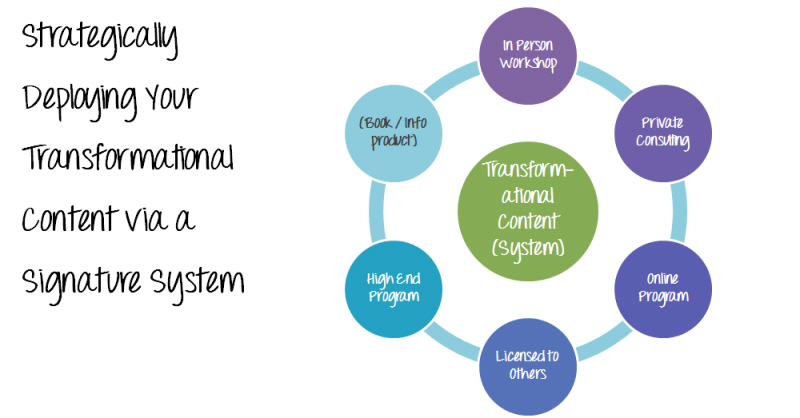
3 things transformational content is and one thing it is not
- It the structured know how that you teach, guide or complete with your clients to make a difference in their lives.
- It is your process, your system, your method of getting results
- It is your packaged intellectual property and will potentially become your most valuable asset when deployed and marketed effectively.
- It is not what you sell.
What you SELL is the state change – the desirable result.
What you don’t sell is the vessel that creates the results
(not to say you are mysterious and “secret-y” about it, but it is not what you lead with).
Start Where They Are
If you completed the exercises with Clarity 2 – Client Insight – you will have done some great work on your ideal client’s starting point and be able to describe in vivid language their current state. You’ll authentically describe the muddy pond, in all its putridness. You can empathise, meet them right where they are and make them feel validated by articulating your familiarity with their immediate situation.
They are SO OVER IT. It doesn’t take much to show them a way out. They are hungry for this transformation, they are ready for it – and you can be honest about what it will really take to get there.
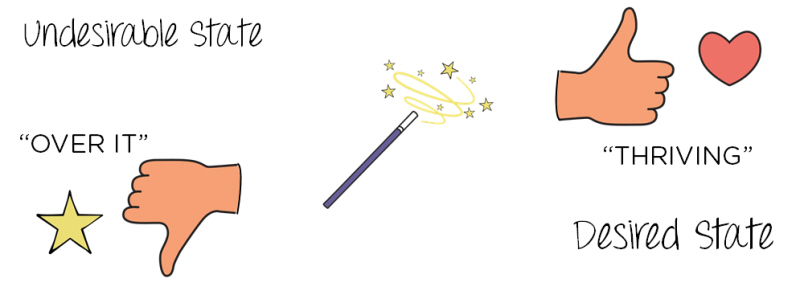
In this illustration, we’ve articulated the undesirable state as “over it”. Our work with the client is represented by the wand, we’ll start articulating our process in a minute.
What comes next is expressing the desired state – the transformation.
(We used “thriving” in the example above)
A great tool for this job is our “so that” approach (which we use to help define benefits in The One Page Brand)
Buy/Do this … so that you can
- get / have / be {this} ….
- build / create / make {this}
- do/accomplish {this task}
- achieve {this outcome / result}
- beat/end {this condition}
One or more of these should get you to the rational or tangible result. For something more aspirational or emotional, you need to probe a little further.
I teach a technique called laddering to uncover descriptions how life is after the transformation. Start your ladder from a tangible outcome above and then ask “how does this feel?”, “what does this mean to you?”
(Obviously asking real clients is vastly preferred but if you can’t do that, use your intuition)
You may need to ask 2 – 3 times to reach the heightened desire state that we discussed earlier.
- feel {this*} heightened state
Really work hard on finding vivid, visceral language that brings this to life in your own voice. This will have ideal clients think you are reading their mind.
So now you have your undesirable (before) state and your highly desirable (after state).
All we need to do now is engineer the vessel that spans the states. We keep it in our back pocket, but our packaged intellectual property is arguably our most important asset beside our Brand.
In fact, you are experiencing transformational content right now. The 7 Clarities is my signature system, and I’m about to tell you how I built it.
Nailing Your Signature System
In early 2015, I had developed a lot of content for True Entrepreneur, my brand was done, website design was done, a workshop was designed and my first info product was written. Everyone was encouraging me to launch my work. I knew I wasn’t ready, I had a strong feeling that something was missing – some kind of container for the work I wanted to do and the difference I believed I could make in the world.
In 2011 and 2012 I had created content and run workshops helping people find their Sweet Spot. (My approach to niching). Over the years I had seen other people do it very well, and yet I still felt in my heart of hearts I had developed something special, and I was loathe to leave it behind.
But how did it fit with my branding work? Could it live beside my insight work and with some of my beliefs about choosing your marketing activities from a place of strength? I had some good content, a fair bit of insight and a lot of ideas but trying to force them together was not working.
My breakthrough emerged from digging into a pain point. I saw entrepreneurs “failing” – becoming overwhelmed and disillusioned because they were being pushed to execute tactics, create products and go to market without their strategic fundamentals in place.
Before they knew themselves as entrepreneurs. And it really did NOT slow them down to do this deeper, reflective, strategic work, in fact, it could speed them up.
Clarity, or rather the absence of it, was the problem that I most wanted to address.
![]()
Not stopping and navel gazing for months on end. To me, clarity means putting aside an afternoon (or maybe two afternoons) to nail your positioning and your strategy in a structured process.
To answer the big questions. To determine your destination and lay out your train tracks and your stations (the latter a metaphor I learned from mentor James Schramko).
To give you a sense of confidence that your business will thrive.
So I linked my problem, disparate pieces that didn’t seem to quite fit together, with a genuine entrepreneurial problem – overwhelm, spinning wheels, disillusionment and offers not connecting.
One afternoon, I put some giant fresh post it notes on my office wall and stood with my marker pen and started the process I describe below.
It came together quickly, (in fact it was one of the great creative moments of my life) and I experienced the creative flow state. Sometimes I couldn’t write fast enough. Sometimes I had to sit in my thinking chair and gaze at the wall.
Luckily I can tolerate a lot of mess and love a blank sheet of paper – I think you need to embrace chaos before you can create a structure. That said, with each iteration I could see some steps emerging – some clarity (geddit?). Even more exciting I could see a lot of my existing content, fitting together in a way that really made sense.
This is big work, take time with it, enjoy it. On that afternoon I had the conscious thought that I still may be talking about the 7 Clarities in 2025. It could be the core of books and programs and maybe even licensing. It wanted to be out in the world, it came through me and I couldn’t hold it back.
6 months later I followed the same process to create the One Page Brand, equally enjoyable, also essentially mapped out in a flurry of inspiration in one afternoon of work. Of course there were iterations and tweaks, but you can sketch your big ideas quite quickly and the rest is detail.
>>>>> It could also be some of the most fun you’ll ever have.
![]()
Let’s get started
My Advice: Don’t work on a keyboard, work on a whiteboard or a blackboard or a wall or a window. I LOVE my giant 3M post it notes, bullet points, arrows, boxes, markers and small post it notes that can be moved around.
Mind mapping is also great. Make a big mess, it’s OK! Work standing up, keep yourself energized and pause every now and then to review. Stay in idea generation mode as long as you can.
Review Your Insight Bank: Imagine an ideal client is right there in the room with you and address your ideas to them. Even better, you could do this with another creative entrepreneur (not a naysayer) like I do for my private clients.
Start With the Result: This is not about finding a market for your products, it is about knowing your clients so intimately that you can build a system to deliver an outcome they already want. (But haven’t been able to achieve on their own).
The most important starting place is vividly expressing the desired state (the before state). This will get you excited about the difference your guidance can make in their lives.
Obstacle Analysis: So now you have a destination, list all the stumbling blocks that a client might hit on their way through (of course you might get a rare individual that just flies through, but your average client will find things hard before they are easy).
Just brainstorm, there is no need to put them in any order. Keep asking the question; what else stops people getting to this outcome.
Breakthrough Analysis: Take each obstacle, turn it around and rephrase it as a breakthrough. These may later become “steps”, but at this stage the flow of ideas is more important. You can work from either end or the middle. (Note: don’t assume your signature program will always be a linear approach).
Pattern Analysis: Are the stumbling blocks and breakthroughs the same for all clients? Or are you noticing patterns which appear according to some commonality? (For example, level of pre-existing knowledge, personality type, business model).
Other Influences: Could anything else be influencing your ideal client’s ability to make these breakthroughs? Perhaps mindset is a limitation (for e.g. confidence), perhaps technical ability, perhaps capacity to invest, almost definitely time to invest in a learning curve will be an issue.
Or perhaps it is a positioning problem, the pain is not urgent or is not costing them money, perhaps credibility is an issue and you will need to add proof.
Don’t ignore issues like these, you may need to reframe or add to your breakthrough points. You might deal with these in accelerated pre-work, a done-for-you service, partnership opportunities or non linear systems in order to maximise the likelihood of your ideal clients getting the results that you promise.
Lacking Insight? Mine Your Own Journey: For some know how entrepreneurs, particularly in emerging fields like social media, or rapidly changing fields like internet marketing, their ideal client is themselves 2 years ago.
If this resonates with you, spend 30 minutes with your notebook working backwards from where you are today and noting each challenge / turning point / lesson that has had a bearing on your current success. Marvel at all you have overcome to get to where you are now. Using this insight, go back over the points above and see what else emerges.
Define Learning Chunks: (Don’t start here till you feel your creative, flow energy on the above questions it is exhausted, because now we start using a different part of the brain.)
Once you are complete with a list of obstacles and breakthroughs, patterns and influences we look to structure the breakthrough points.
You have a linear system if he know how layers on itself from a base of pre-requisite knowledge. Create an order of logical steps that layer in the learning. (Naming probably comes later, you can use placeholder names or numbered steps for now).
So this is your spine. Book-ended by the before state and the after state, each step builds on the previous to deliver the transformation.
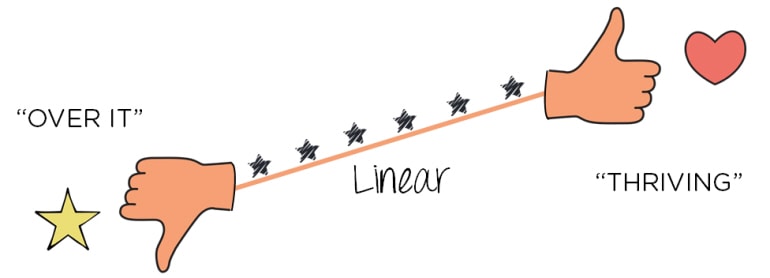
The order not always obvious, I’ve put more thinking time into the order of Clarity 5 and Clarity 6, Revenue Model and Product Strategy, that it took to create the entire 7 Clarities. They are inter related and co-dependent, and hard to separate. My solution when I’m working through the 7 Clarities with private clients is not to get too hung up on the order, and cross check the strategy. Hopefully, if yours is a linear process, the steps are fairly clear.
If you have some steps, just answer this final question: Is the first step really the first step? The first step is all important because this is what you will more than likely pitch. So, does your first step solve an urgent problem for your ideal client?
Are There Other Types of Systems? absolutely there are, you don’t necessarily need steps, you could also create value via different approaches for pre classified segments or create a “choose your own adventure” model.
If you noted a number of patterns and influences in the questions above, non-linear models may be more suited to you.
The first picture is of a segmentation based system, where you use some prequalifying questions to put people into segments. This works because people love to be told about themselves, and respond to information which seems more customised for their needs.
Some examples of segment based signature systems are the Myers Briggs type indicators, Brand Archetypes or The Enneagram.
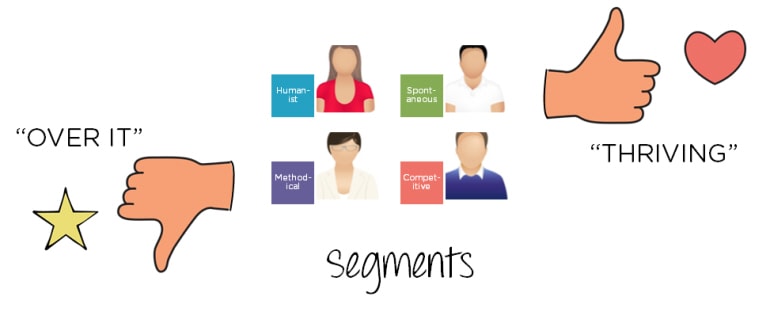
Another signature system could be a matrix structure, where different strategies apply in different situations. A matrix can create a bespoke strategy quite quickly. Clients would consume the relevant content in what ever order best fits their situation and priorities.
I recently worked with client to develop a Profit Matrix for his consulting business. It had 5 profit levers across the top and 5 business stall points down the side. In each box was a different proven growth strategy. By identifying the current stall point combined with the profit lever that had the most potential for the business, it was easy to generate strategy ideas and prioritise their implementation.
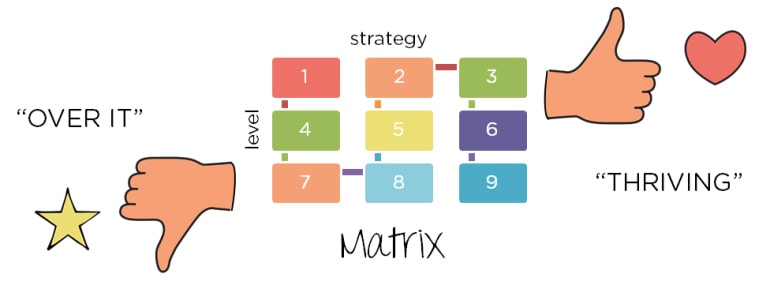
Why Can’t I Promote the Hell Out of My Transformational Content When I’m so Damn Proud of It?
Well, obviously you can, but you might not have great success on the sales side. Because you would be talking about yourself, rather than showing clients a way out and what is possible.
A few observations about selling that I’ve picked up by watching the best:
- People don’t buy what you do, they buy why you do it. Simon Sinek Start With Why TED Talk. The opportunity is to show why it means so much to you to be a part of this transformation in the life of your clients. And I know that is the honest truth, it does mean the world to you.
- You are not solving the whole problem, you are solving the immediate issue. So look back at the work you did in Clarity 2 – Client Insight and make sure you have all your symptoms and triggers nailed. Then you’ll address just those in creating your lead magnet and sales funnels. Because it is part of your job to lead people on the road to transformation. All you ever sell is the next step.
- People don’t buy what they need, they buy something they want. Chris Haddad is a great copywriter who told an excellent story in some training he created for Mind Valley. He wanted to help men have better and more fulfilling relationships with women and he had great transformational content to do that. However they weren’t buying. So what did he sell? “How to get head” (forgive the vulgarity). Successful? Err …. yes. Here is a link to a great post by Amy and Tom Birks with further details on this strategy and the Chris Haddad story, including a link to the video.
- Give them compelling reasons to believe. We don’t go all “feature crazy” piling on reasons to buy because we are selling the transformation. Eventually they will want to look under the hood, but initially, hold back on the detail. Show them how it will work for them and is working for people just like them. Gather “in their own words” social proof, testimonials and case studies.
If you are at early stages, work with people in beta for reduced fees in return for constructive feedback and testimonials. Ask those people to help you tweak your system, but also your pitch.
OK, BUT, BUT, BUT, I’M STRUGGLING
I have a whole bunch of products and programs but none of them are a signature system.
This was the problem I described above. I also tried to force fit stuff together. My breakthrough came by starting with the problem of confusion and overwhelm and really digging in to it. I tried not to be attached to any of my existing content, and yet, when I saw the 7 Clarities emerge, about 70% of it found a place.
The best thing to do in this case is identify the content that most energizes you, and the highest good you want to bring to world and then look for the overlap in the insights you’ve developed about your ideal client.
If you already have a good number of clients talk to them in as much depth as you can about the before, during and after.
I’m not a very systematic person, my work is pretty organic and I don’t know anything about creating a structure
This is a common problem and surprisingly easy to address with some empathy and understanding. I used to wholeheartedly resist structure in my life and work, until I had an *ephiphany* that structure sets you free.
It gives you a base you can leverage into each interaction. It underpins your confidence that you can create results. I have no doubt in my mind that if you are good at what you do, it will likely be right under your nose, You might just need some assistance to recognise the patterns and build out the spine.
If you have defined your ideal client and mined for insight, you are more than likely ready to package your transformational content. And it will be so worthwhile, it will give you that bedrock of confidence and clarity that has been missing. You will be creating an asset that could be put to many uses over many years … and make your fortune.
AND, it’s fun and empowering.
I truly love rolling up sleeves with entrepreneurs and co-creating signature systems in my “Find Your Formula” private workshops. Please contact me if I can assist, I would certainly love to.
Read on to Clarity 4 – Magnetizing Brand
If you like this article, please share.

